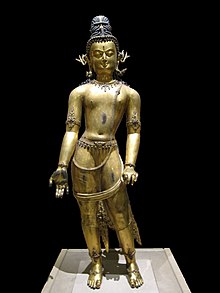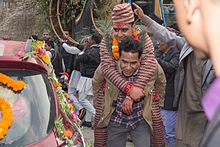நேபாளச் சமயங்கள்
2011 இல் நேபாளச் சமயங்கள்[1]


நேபாளச் சமயங்கள் (Religion in Nepal) 2011 நேபாள மக்கள் தொகை கணக்கெடுப்பின் படி, நேபாளத்தின் பெரும்பான்மையான மக்கள் (81.3%) இந்து சமயத்தை பின்பற்றுகிறார்கள். நேபாளத்தில் மன்னராட்சி நடைபெறும் வரையில், இந்து சமய சார்புடைய நாடாக இருந்தது. பின்னர் 2008 ஆண்டு முதல் மதச்சார்ப்பற்ற நாடானது. நேபாளத்தில் இந்து சமயத்திற்கு அடுத்து இரண்டாம் இடத்தில் பௌத்த சமயத்தை (9%) பின்பற்றுபவர்கள். இசுலாம் சமயத்தை 4.4% பின்பற்றுகிறார்கள். நேபாளப் பழங்குடி சமயத்தைப் பின்பற்றும் கிராதர்கள் மக்கள் தொகையில் 3% ஆக உள்ளனர். கிறித்துவத்தை பின்பற்றுபவர்கள் 1.4% ஆக உள்ளது. பிற சமயத்தை பின்பற்றுபவர்கள் 0.8% ஆக உள்ளனர்.
நேபாளத்தில் இந்து புனித யாத்திரைத் தலங்கள் மற்றும் பௌத்த யாத்திரைத் தலங்கள் அதிகம் கொண்டுள்ளது.[2][3][4][5][6][7] இந்துக்கள் புனிதமாக வணங்கும் பசுவை, நேபாள நாட்டின் தேசிய விலங்காக அறிவிக்கப்பட்டுள்ளது.[8][9] எனவே பசு வதை சட்டம் நேபாளத்தில் நடைமுறையில் உள்ளது.[10]
தங்கள் சமயத்தை பின்பற்றும் உரிமை மக்களுக்கு அரசியலமைப்புச் சட்டம் வழங்கியிருப்பினும், பிற சமயத்தவர்களை நேரடியாகவும், மறைமுகமாகவும் கட்டாய மதமாற்றம் செய்யும் வழக்கம் நேபாள அரசியலமைப்புச் சட்டம் தடை செய்கிறது. ஆனால் ஒரு நபர் தன்னிச்சைப்படி மதம் மாற அனுமதிக்கப்பட்டுள்ளார். 2008ஆம் ஆண்டிற்கு முன்னர் நேபாளம் இந்து சமய நாடாக இருந்தது. நேபாளத்தின் புதிய அரசியலமைப்புச் சட்டப்படி தற்போது மதச்சார்பற்ற நாடாக விளங்குகிறது.[11]
வரலாறு[தொகு]

Nepal has had Hindu dharma and Buddhist dharma from the beginning of recorded history in the area, though it originally had only Kiratism and other tribal religions; Islam was introduced to the nation around the 11th century with the arrival of Muslim Indians. Christianity was introduced to the country in the 1700s when Catholic friars entered the Kathmandu valley and Christian missionaries are active throughout the country. Sikhism came to Nepal during the 18th century and spread throughout Nepal, and Jainism came to Nepal during the 19th century but spread only to Kathmandu and some districts of Nepal. Both Sikhism and Jainism are an integral part of Nepal now and both constitute a significant role in Nepalese identity and culture, though they are Indian-born Dharmic religions.
Religious tolerance can be found in royal orders dated Falgun Sudi 12, 1884 V.S. issued by the Hindu Shah monarch Rajendra Bikram Shah under the premiership of Bhimsen Thapa to Buddhist monks in the Kingdom of Nepal:
Our father (i.e. King Girban) has issued a copper plate inscription declaring that nobody shall harass you so long as you observe traditional religious practices (dharma). We hereby reconfirm that order.
According to the 2011 census, 81.3% of the Nepalese population is Hindu, 9.0% are Buddhist, 4.4% are Muslim, 3.0% are Kiratist (indigenous ethnic religion), 1.4% are Christian, 0.1% are Sikhs, 0.1% are Jains and 0.7% follow other religions or no religion.[1] This varies from the 2001 census, where 80.62% percent of Nepalese were Hindu, 10.74% were Buddhist, 4.20% Muslim,[13] 3.60% Kirant (an indigenous religion), 0.45% Christian, and 0.4% were classified as other groups such as Bön. In 1971 Hindus were 89.4% of the population, Buddhists 7.5%, and Kirants statistically 0%. However, statistics on religious groups are complicated by the ubiquity of dual-faith practices, particularly among Hindus and Buddhists.
The geographical distribution of religious groups in the early 1990s revealed a preponderance of Hindus, accounting for at least 87% of the population in every region. The largest concentrations of Buddhists were found in the eastern hills, the Kathmandu Valley, and the central Tarai; in each area about 10% of the people were Buddhist. Buddhism was more common among the Newar and Tibeto-Nepalese groups. Among the Tibeto-Nepalese, those most influenced by இந்து சமயம் were the Magar, Sunuwar, and Rai peoples. Hindu influence was less prominent among the Gurung, Limbu, Bhote, Tamang and Thakali groups, who continued to employ Buddhist monks for their religious ceremonies. Since both Hinduism, as well as Buddhism, are Dharmic religions, they usually accept each other's practices and many people practice a combination of both. In 2015, a new constitution was adopted and granted equal rights to all religions in Nepal. However, influencing others to change their religion is prohibited.[14] There has been political pressure from India's Hindu party that it should become a Hindu government again but it has received a negative response from the Nepalese government.
Nepal's constitution doesn't give anyone the right to convert any person to another religion. Nepal also passed a more stringent anti-conversion law in 2017.[15][16] The ban on evangelism has been protested by Christian groups in the country.[17]
மக்கள் தொகை பரம்பல்[தொகு]
| சமயம் | மக்கள் தொகை | % |
|---|---|---|
| இந்து சமயம் | 21,551,492 | 81.34% |
| பௌத்தம் | 2,396,099 | 9.04% |
| இசுலாம் | 1,162,370 | 4.39% |
| பழங்குடிகள் | 807,169 | 3.04% |
| கிறித்துவம் | 375,699 | 1.41% |
| இயற்கை வழிபாட்டாளர்கள் | 121,982 | 0.46% |
| போன் பௌத்தம் | 13,006 | 0.04% |
| சமணம் | 3,214 | 0.01% |
| பகாய் சமயம் | 1,283 | 0.01% |
| சீக்கியம் | 609 | 0.01% |
| பிறர்/சமயம் குறிப்பிடாதோர் | 61,581 | 0.23% |
| மொத்தம் | 26,494,504 | 100% |
சமயப் புனிதத் தலங்கள்[தொகு]
இந்து யாத்திரைத் தலங்கள்[தொகு]
- பசுபதிநாத் கோவில்
- முக்திநாத்
- கங்காலினி கோயில்
- கும்பேஷ்வரர் கோயில்
- சங்கு நாராயணன் கோயில்
- சம்புநாத் கோயில்
- சித்திகாளி கோவில்
- சின்னமஸ்தா பகவதி கோயில்
- தக்சின்காளி கோயில்
- பக்தபூர் நகர சதுக்கம்
- பதான் அரண்மனை சதுக்கம்
- பூதநீலகண்டர் கோயில்
- ஜானகி கோயில்
பௌத்த யாத்திரைத் தலங்கள்[தொகு]
இசுலாமிய பள்ளிவாசல்கள்[தொகு]
நேபாளப் பண்பாட்டில் இந்து சமயம்[தொகு]


According to Nepalese theology Lord Brahma, Vishnu and Shiva had come to Nepal in the form of deer.[19]
நேபாளத்தின் கொடி[தொகு]
1962-இல் புதிதாக வடிக்கப்பட்ட நேபாளக் கொடியில் வளர்பிறை வெள்ளை நிலாவும், சந்திரன் மற்றும் 12 கதிர்களுடன் கூடிய சூரியனும் இடம் பெற்றுள்ளது.[20] இக்கொடியை பகவான் விஷ்ணு மக்களுக்கு வழங்கியதாக நேபாள மக்கள் நம்புகின்றனர்.
இதனையும் காண்க[தொகு]
மேற்கோள்கள்[தொகு]
- ↑ 1.0 1.1 Statistical Yearbook of Nepal - 2013. Kathmandu: Central Bureau of Statistics. 2013. பக். 23 இம் மூலத்தில் இருந்து 18 செப்டம்பர் 2016 அன்று. பரணிடப்பட்டது.. https://web.archive.org/web/20160918034634/http://cbs.gov.np/publications/statisticalyearbook_2013. பார்த்த நாள்: 13 December 2015.
- ↑ "South Asia :: Nepal — The World Factbook - Central Intelligence Agency". www.cia.gov. Archived from the original on 2010-12-29. பார்க்கப்பட்ட நாள் 2019-07-01.
- ↑ "Same Same But Different: Religion in Nepal". Inside Himalayas (in அமெரிக்க ஆங்கிலம்). 2018-06-20. பார்க்கப்பட்ட நாள் 2019-07-01.
- ↑ "Is Nepal a Hindu state or secular?". ucanews.com (in ஆங்கிலம்). பார்க்கப்பட்ட நாள் 2019-07-01.
- ↑ "Nepal Adopts New Constitution, Becomes a Secular State: 5 Facts". NDTV.com. பார்க்கப்பட்ட நாள் 2019-07-01.
- ↑ "Visit the "Guardian Deity of the Himalayan Country" Pashupatinath". Advice, Blogs & Stories (in அமெரிக்க ஆங்கிலம்). பார்க்கப்பட்ட நாள் 2019-10-09.
- ↑ mountainmartpr (2017-06-29). "10 UNESCO World Heritage Sites of Nepal". Adventure Holidays in Nepal (in அமெரிக்க ஆங்கிலம்). Archived from the original on 2019-07-01. பார்க்கப்பட்ட நாள் 2019-07-01.
- ↑ "Cow becomes national animal of Nepal". News18. பார்க்கப்பட்ட நாள் 2019-07-01.
- ↑ "Sanctity of the cow | Hinduism". Encyclopedia Britannica (in ஆங்கிலம்). பார்க்கப்பட்ட நாள் 2019-07-01.
- ↑ Ojo, Kehinde (2 November 2018). "Nepal's Cattle Slaughter Ban: Impacts on Dairy Producers' Profit". AGRILINKS. பார்க்கப்பட்ட நாள் 1 July 2019.
- ↑ "Religious freedom in Nepal 'teetering on the edge'". World Watch Monitor (in அமெரிக்க ஆங்கிலம்). பார்க்கப்பட்ட நாள் 2019-07-31.
- ↑ Regmi 1987, ப. 18.
- ↑ "MUSLIMS of NEPAL: Becoming an assertive minority". October 13, 2007.
- ↑ Ochab, Ewelina U. "Nepal's Protection Of Religious Freedom On Downward Spiral". Forbes.
- ↑ "Nepal's new law puts squeeze on Christians - UCA News". ucanews.com (in ஆங்கிலம்). பார்க்கப்பட்ட நாள் 2020-12-12.
- ↑ "Nepal: Nepal: Bill criminalises religious conversion". www.csw.org.uk. பார்க்கப்பட்ட நாள் 2020-12-13.
- ↑ Shellnut, Kate (25 October 2017). "Nepal Criminalizes Christian Conversion and Evangelism". Christianity Today. https://www.christianitytoday.com/news/2017/october/nepal-criminalizes-conversion-christianity-evangelism-hindu.html.
- ↑ "Population Monograph of Nepal Volume II (Social Demography)" (PDF).
- ↑ History of Nepal: With an Introductory Sketch of the Country and People of Nepal, Daniel Wright
- ↑ "Flag of Nepal". Encyclopedia Britannica. பார்க்கப்பட்ட நாள் 2019-07-31.
ஆதாரங்கள்[தொகு]
- Regmi, Mahesh Chandra (1987), Regmi Research Series, vol. 19, Regmi Research Centre

